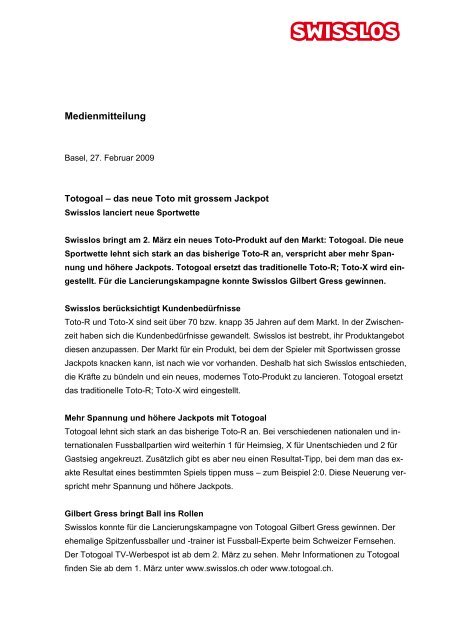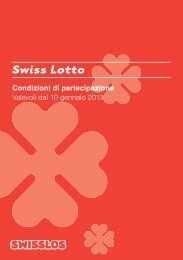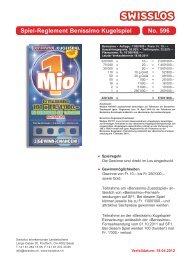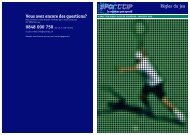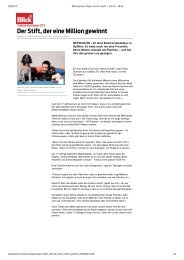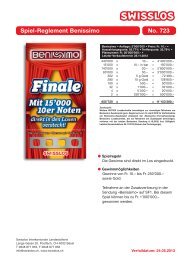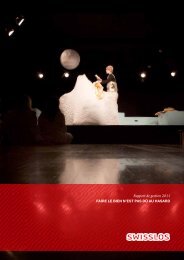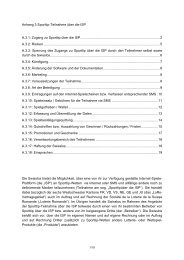Totogoal von Swisslos (pdf)
Totogoal von Swisslos (pdf)
Totogoal von Swisslos (pdf)
Create successful ePaper yourself
Turn your PDF publications into a flip-book with our unique Google optimized e-Paper software.
PerotinSederuntThis is the famous "Sederunt" of Perotin.I have given each part its proper name; Tenor, Duplum, Triplum, and Quadruplum, at thestart of the score.If you don't know what this music is all about, I suggest you consult the Perotin article on Wikipedia.Here's the capsule version: After hundreds of years of singing the same old thing in church, that is,"Gregorian" plainchant where a group of male voices all sang exactly the same thing with no instrumentalaccompaniment (such as 'Dies Irae'), church composers, maddened with boredom, finally convinced theirsuperiors to allow them to experiment a little, such as by having different voices sing different things at thesame time. Harmony and counterpoint were thus born.In the late 12th century in Paris, one idea that arose was to take a known chant and stretch it out so thateach syllable was sustained for a long time, like a bagpipe drone or a 'pedal tone' on an organ; on top ofthese long sustained notes, a few other voices would sing composed parts, using nothing more than thevowel of the drone syllable. For example, if the 'Tenor' -- the voice holding the extended syllables of theoriginal chant -- sang and held the syllable 'Se' from the word 'Sederunt', the ensemble would all be singingthe vowel 'e' until that syllable ended and the next began. ('Tenor' in fact is derived from a Latin verbmeaning 'to hold.')Perotin was not the first man to compose music in this style, called 'Organum' -- the earliest knownpolyphony -- but he is certainly the most well known in our time. Music-history students have almost alwaysbeen introduced to Perotin, but the vast majority of other people who know the name these days probablyowe that to the recordings and performances of England's great Hilliard Ensemble. I encourage you to seekout their CD, 'Perotin.' You can follow this score as you listen to their interpretation.The Tenor part (the lowest one, with the long pedal notes) is not really notated as it should be forthis style of music; you will see many repeated and tied notes. You will notice, if youhave never seen this type of music before, that many of the Tenor notes are thus EXTREMELYlong. Two or three instruments or singers are meant to do this part, I suppose, in order to maintainthe note during breaths. An organ would do the trick as well.
Beilage:• Detailliertes Factsheet• Auszüge Werbekampagne• Spielschein<strong>Swisslos</strong> ist für den Vertrieb und die Vermarktung aller Lotto-, Los- und Sportwettenproduktein den Deutschschweizer Kantonen, im Kanton Tessin und im Fürstentum Liechtenstein zuständig.Die Sportwetten hat sie 2007 <strong>von</strong> der Sport-Toto-Gesellschaft übernommen. Sieschüttet ihren Reingewinn vollumfänglich an die kantonalen Lotterie- und Sport-(Toto-)Fondsaus. Mit diesen 350 Millionen Franken pro Jahr werden gemeinnützige Projekte in den BereichenKultur, Sport, Natur, Soziales und Entwicklungshilfe unterstützt.Weitere Auskünfte:Roger Fasnacht, Direktor <strong>Swisslos</strong>T +41 61 284 11 11, media@swisslos.chausserhalb der Bürozeiten: 079/ 419 77 44


